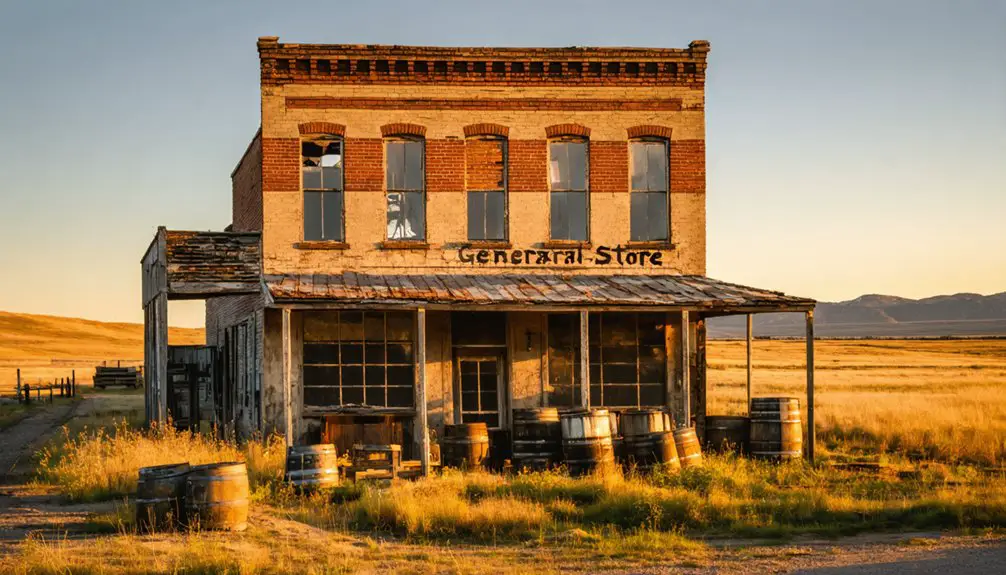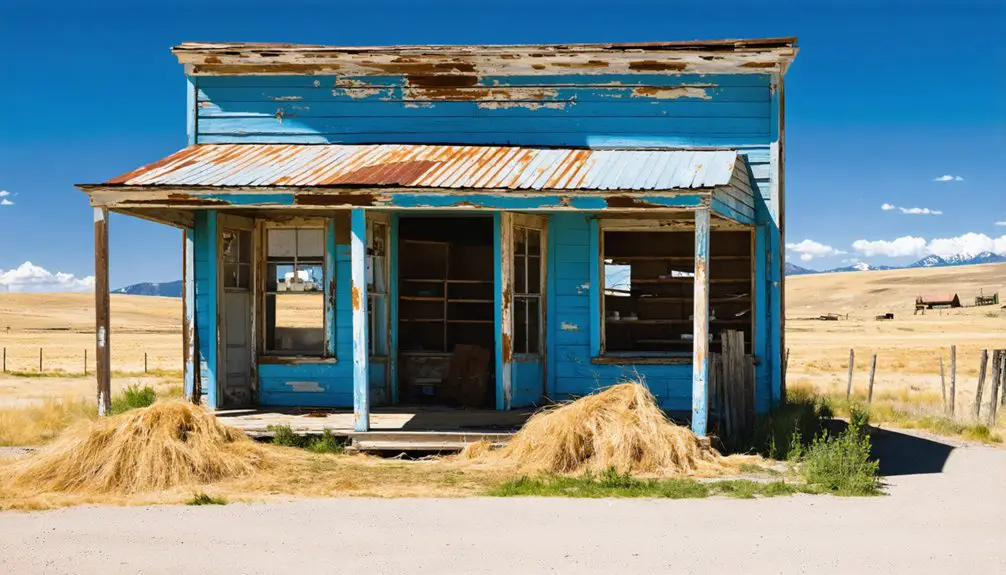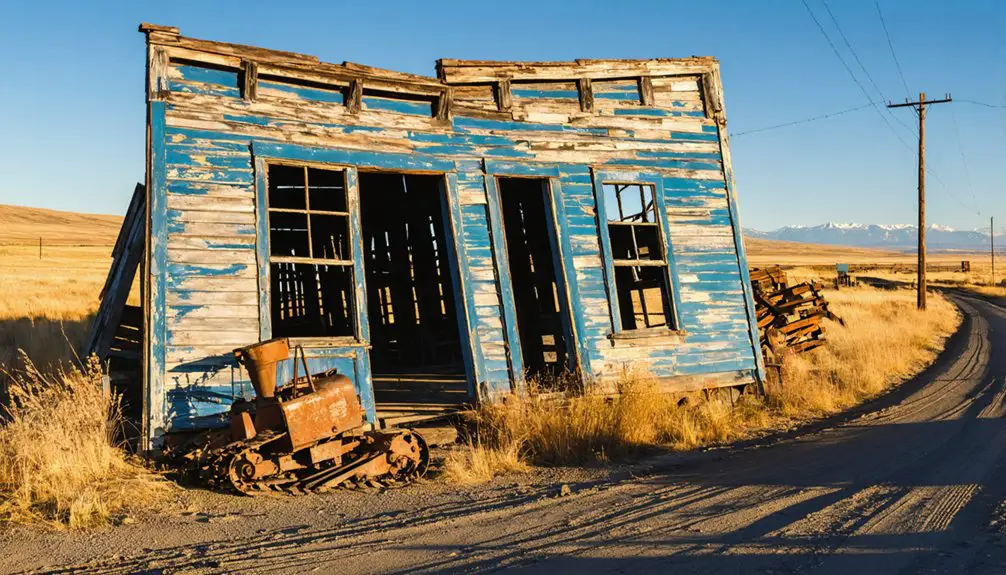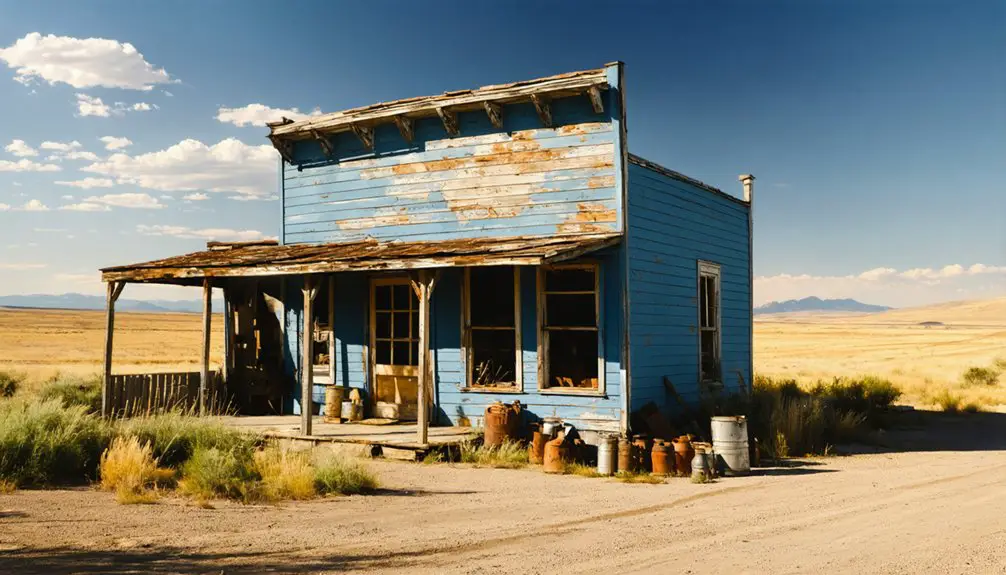You’ll find Carter, Montana’s story unfolds through three different names – O’Rourke, Carter, and Keystone – as it evolved into a silver mining boomtown during the 1890s. The town reached its peak when silver hit $1.21 per troy ounce under the Sherman Silver Purchase Act, attracting nearly 1,000 residents by 1898. While its mines once produced part of Montana’s 19 million troy ounces of silver in 1892, the town’s most intriguing chapter emerged during Prohibition.
Key Takeaways
- Originally named O’Rourke, Carter became a thriving Montana mining town in 1891, named after Senator Thomas Carter.
- The town reached its peak population of 1,000 residents in 1898, featuring four hotels, four stores, and three livery stables.
- Carter’s economy relied heavily on silver mining until the 1893 repeal of the Sherman Silver Purchase Act devastated local operations.
- During Prohibition, abandoned mines were repurposed for moonshine production, with John Hartman’s New Idea mine serving eastern Idaho customers.
- The town’s decline was marked by silver price collapse, mine closures, and population exodus, eventually becoming a ghost town.
The Story Behind Three Town Names
While Montana’s ghost towns often derived their names from natural resources, political figures, or practical necessity, three towns in particular illustrate this naming diversity.
Montana’s abandoned settlements showcase a rich tapestry of naming origins, from mineral wealth to political homage to practical concerns.
You’ll find O’Rourke’s town naming journey especially intriguing – it became Carter in 1891 to honor Senator Thomas Carter when establishing its post office, then transformed into Keystone due to another Montana town already claiming the Carter name. Mining was vital to the town’s early success, with five prospectors first establishing it in 1887 when exploring Spring Gulch.
The historical significance of natural resources played a key role in Garnet’s identity, as it drew its name from the semi-precious ruby-colored stones found in the surrounding area. The town flourished into a bustling community with thirteen saloons during its peak.
This pattern of place naming reflected the era’s priorities: political influence, administrative practicality, and the wealth of natural resources that drew settlers to these frontier communities.
Silver Mining’s Golden Age
If you’d visited Carter during Montana’s silver peak in 1890-1893, you’d have witnessed the dramatic impact of the Sherman Silver Purchase Act, which temporarily boosted silver prices to $1.21 per troy ounce and fueled unprecedented mining activity.
Montana’s silver production reached its zenith in 1892 with 19 million troy ounces extracted statewide, making it America’s second-largest silver producer. Mining operations in Butte alone produced 4,000 tons of ore daily, demonstrating the region’s immense productivity.
The silver boom’s abrupt end came in 1893 when Congress repealed the Sherman Act, causing silver prices to plummet and forcing many mining operations to close, leaving towns like Carter to face severe economic hardship.
While many mines struggled during this period, the Drumlummon Mine’s wealth had already established itself as a significant contributor to Montana Territory’s economy through earlier gold and silver discoveries.
Sherman Act’s Local Impact
Because Montana’s silver mining industry heavily relied on government purchasing programs, the 1893 repeal of the Sherman Silver Purchase Act devastated local mining operations and communities.
You’d have witnessed the dramatic silver price collapse that forced numerous mines to shut down between 1893-1897, including the Elkhorn, Granite-Bimetallic, Alice, and Lexington operations.
Mining community challenges intensified as deeper excavation became necessary, with costly water pumping and zinc penalties up to 50 cents per percentage point above 12% making operations unprofitable.
Similar to modern environmental concerns in the Cabinet Mountains Wilderness, mining operations of the era faced increasing scrutiny over their impact on local water resources.
Even promising mines like Hope and Castle, which briefly survived through new ore discoveries, couldn’t maintain long-term viability.
The repeal’s impact rippled through Montana’s economy, destroying jobs and crippling businesses that supported the mining industry.
The legacy of this mining era left behind abandoned mine sites that continue to pose environmental challenges for the state today.
Peak Production Years 1890-1893
Montana’s silver mining industry reached unprecedented heights during the early 1890s, with statewide production peaking at 19 million troy ounces in 1892. During this period, Carter’s economy thrived alongside major districts like Philipsburg and Butte, which produced 35.6% and 43.2% of the state’s silver respectively.
Mining techniques evolved rapidly, with advanced smelting operations processing unprecedented volumes – Butte handling 4,000 tons daily and Anaconda 2,500 tons. The Lewisohn brothers transformed mining operations by purchasing major mines across Montana in 1879.
You’ll find that technological innovations transformed the industry between 1891-1893. New machinery like Brückner cylinders and reverberatory furnaces boosted efficiency, while the Boston and Montana Consolidated’s state-of-the-art smelter complex employed over 1,000 workers.
Major mines like Granite Mountain and Bimetallic distributed substantial dividends, reaching $2.5 million in 1892 alone. The Sherman Silver Purchase Act of 1890 provided temporary support for the mining operations before the industry’s collapse.
Post-Silver Economic Fallout
While silver mining boomed in the early 1890s, the industry faced devastating setbacks after the Fourth Coinage Act of 1873 demonetized silver and moved the U.S. to a gold standard. By 1889, silver prices had plummeted to $0.93 per ounce, triggering the Panic of 1893 that ravaged Montana’s mining economy.
You’ll find that Carter, like many silver towns, struggled as mines scaled back operations or shuttered completely. The Granite Mountain Mining Company demonstrated the volatility of the era by paying out $12,000,000 in dividends before the crash of 1893. Economic diversification became essential for survival, with some operations shifting to gold and copper extraction.
Mining labor conditions improved during this tumultuous period, with workers securing an eight-hour workday by 1901. While some towns transformed their economies through infrastructure projects and alternative industries, Carter’s fate was sealed by the silver collapse, leading to claim abandonments and a dramatic population exodus.
Life During the Boom Years
During Carter’s peak in January 1898, you’d find nearly 1,000 residents bustling between four hotels, four stores, and three livery stables that served as the town’s commercial backbone.
You could get a haircut at one of two barber shops before heading to the saloons or miner’s union hall, which functioned as key social gathering spaces.
The presence of boarding houses and a post office helped create a stable community environment where miners and their families could establish daily routines beyond the demanding work in the mines. The town’s early prosperity came from the discovery of quartz gold in 1887, which drew the first wave of settlers to the area.
Daily Town Activities
Life in Carter bustled with activity as miners, merchants, and townspeople created a vibrant community centered around the town’s flourishing mining operations.
You’d find miners heading to work at the Nancy Lee, Emmet, and New Idea mines, while merchants opened their shops to supply essential goods and mining equipment. Daily routines revolved around the rhythms of mine shifts, with workers stopping at boarding houses for meals or visiting the local barber between shifts.
Community gatherings often took place at the miners union hall, where you could participate in organizational meetings or civic activities. The post office served as a crucial hub for communication, while the school educated the miners’ children.
When work ended, you’d see residents socializing at public halls or conducting business at local establishments that kept the town’s economy moving.
Social and Entertainment Scene
At the height of Carter’s boom years, social life revolved around a network of vibrant establishments where miners and townspeople could unwind after grueling shifts.
You’d find the town’s hotels serving as primary entertainment venues, offering lodging and social gatherings where visitors mixed with locals. The saloons buzzed with card games, drinking, and occasional performances by traveling musicians.
If you were a miner, you’d likely spend evenings at the boarding houses or union halls, where camaraderie flourished among workers.
The gender dynamics were distinctly male-dominated, though women managed boarding houses and worked in hotels. During celebrations, you’d join festivities in hotel parlors or union halls, while gambling and betting on mining claims remained popular pastimes.
The general store and post office doubled as informal meeting spots where you’d catch up on local news.
The Sherman Act’s Impact

While Montana’s ghost towns often reflect the typical boom-and-bust cycles of mining communities, Carter’s decline uniquely showcases the Sherman Act‘s far-reaching effects on local economies.
When Congress enacted this groundbreaking antitrust legislation in 1890, you’d have seen immediate implications for Carter’s business landscape. The law’s strict regulations against monopolistic practices and price-fixing directly impacted the town’s major commercial enterprises, which had previously controlled local market competition through exclusive agreements.
As the Department of Justice began enforcing the Sherman Act’s provisions against restraints of trade, Carter’s business owners faced new challenges.
You would’ve witnessed the dissolution of several local trusts that had maintained artificial price controls, ultimately contributing to the town’s economic instability and eventual abandonment.
From Copper Mines to Secret Stills
Mining in Carter took an unexpected turn after the 1911 discovery of gold by Lou McHaffey and Sam J. Wilson.
While copper mining operations like the Nancy Lee mine initially drove the area’s growth, by the 1920s, the industry had begun to wane. That’s when enterprising individuals like John E. Hartman saw a different opportunity in these remote locations.
You’ll find that during Prohibition, many of Carter’s abandoned mines transformed into secret moonshine operations.
Hartman cleverly disguised his distilling equipment as mining apparatus at the New Idea mine, using copper tubing to produce alcohol for eastern Idaho’s thirsty customers. His operation proved incredibly profitable until his mysterious disappearance.
The shift from copper mining to moonshine production reflected the resourceful spirit of Carter’s residents during challenging economic times.
A Once-Thriving Community

The once-sleepy settlement of O’Rourke transformed into the bustling town of Carter in 1890, named after Thomas H. Carter, who secured the town’s post office. You would’ve found remarkable community resilience as mining families established roots alongside the silver and copper operations that drove the town’s rapid growth.
Despite the rugged mountain terrain, Carter thrived with essential amenities you’d expect in a frontier town. By 1887, you could visit the hotel, shop at general stores supplied by Missoula freight lines, or grab a drink at the saloon.
The town’s social fabric centered around the miners union hall, school house, and boarding houses. Multiple businesses, from blacksmiths to butcher shops, served the daily needs of residents, creating a self-sufficient community until the Silver Purchase Act’s repeal in 1893 disrupted the town’s momentum.
The Town’s Gradual Fade
As Sherman’s Silver Purchase Act unraveled in 1893, Carter’s economic foundation began to crumble.
You’d have witnessed the swift economic decline as silver prices plummeted, driving away mining investment and triggering a mass exodus of residents. The post office’s closure in the early 1900s marked the beginning of community disintegration.
World Wars I and II dealt additional blows, drawing miners away to war efforts or defense industries.
While you might’ve seen a brief glimmer of hope in the late 1930s when rising gold prices attracted some miners back, it wasn’t enough to sustain the town.
By 1960, the Montana School of Mines officially declared the mining operations dead.
Without its economic lifeline, Carter’s remaining infrastructure crumbled, and the last residents departed, leaving behind a silent memorial to boom-and-bust mining economics.
Modern Traces of Mining Heritage

Today, scattered remnants of Carter’s mining legacy dot the rugged Montana landscape, offering silent testimony to the town’s industrial past.
You’ll find evidence of early 20th-century mining technology in the preserved shafts, tunnels, and abandoned stamp mills that once processed precious gold ore. The cultural memory of this once-bustling mining town lives on through local tales, including stories of resourceful miners who repurposed their equipment during Prohibition to produce moonshine.
- Original mining shafts and processing sites remain visible, showcasing 1911-era extraction methods
- Foundations of miners’ cabins and equipment ruins tell stories of daily industrial life
- Historic trails and claim markers reveal the geographic scope of Carter’s mining operations
The site’s minimal preservation means you’re free to explore these authentic remnants of Montana’s mining heritage, though they continue to weather nature’s elements.
Frequently Asked Questions
What Indigenous Tribes Originally Inhabited the Area Before Carter Was Established?
Like stars across the Montana sky, you’ll find Native tribes including the Assiniboine, Sioux, Mandan, Hidatsa, and Arikara nations shaped the cultural heritage before Carter’s establishment, with Oglala Lakota maintaining strong ties.
How Did Early Settlers Transport Mining Equipment to This Remote Location?
You’d have seen freight wagons hauled by ox teams traversing treacherous mountain paths, employing transport methods that could move up to 15,000 pounds of mining equipment through Montana’s challenging terrain per load.
What Happened to the Original Town Records and Documents?
Like files lost in a computer crash, Carter’s town archives vanished when mining collapsed in 1893. You won’t find the original documents – poor preservation and post office closures in 1894 destroyed these records.
Were There Any Major Accidents or Disasters in Carter’s Mines?
You won’t find records of major mine disasters in Carter’s operations. While Montana had significant mining accidents and poor mine safety elsewhere, no documented disaster response specifically links to Carter’s mines.
Which Notable Historic Buildings From Carter Still Exist Today?
You’ll find a well-preserved southern house with original plaster and some tin-roofed structures of architectural significance still standing. Historic preservation efforts have maintained these remnants, including several mining-related building ruins.
References
- https://www.garnetghosttown.org/history.php
- https://www.budgettravel.com/article/montana-ghost-towns
- https://www.historynet.com/keystone-montana-ghost-town/
- https://www.youtube.com/watch?v=lJy7Q8kNbGU
- https://southwestmt.com/ghosts/ghost-towns/
- https://cfwep.org/clark-fork-info/history/1860s-gold-silver-and-early-mining/
- https://archiveswest.orbiscascade.org/ark:/80444/xv28731
- https://en.wikipedia.org/wiki/Montana_silver_mining
- https://westernmininghistory.com/mine-detail/10124372/
- https://earthjustice.org/article/feds-approve-copper-and-silver-mine-in-montana-s-cherished-wilderness



